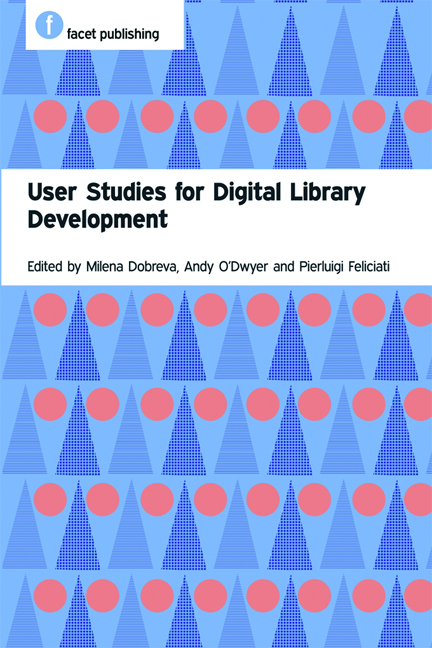Book contents
- Frontmatter
- Contents
- Preface
- Acknowledgements
- Abbreviations
- Glossary
- 1 Introduction: user studies for digital library development
- PART 1 SETTING THE SCENE
- PART 2 METHODS EXPLAINED AND ILLUSTRATED
- PART 3 USER STUDIES IN THE DIGITAL LIBRARY UNIVERSE: WHAT ELSE NEEDS TO BE CONSIDERED?
- 11 User-related issues in multilingual access to multimedia collections
- 12 Children and digital libraries
- 13 User engagement and social media
- 14 Significant others: user studies and digital preservation
- 15 The shift to mobile devices
- 16 Resource discovery for research and course design
- 17 Support for users within an educational or e-learning context
- PART 4 USER STUDIES ACROSS THE CULTURAL HERITAGE SECTOR
- PART 5 PUTTING IT ALL TOGETHER
- Index
12 - Children and digital libraries
from PART 3 - USER STUDIES IN THE DIGITAL LIBRARY UNIVERSE: WHAT ELSE NEEDS TO BE CONSIDERED?
Published online by Cambridge University Press: 08 June 2018
- Frontmatter
- Contents
- Preface
- Acknowledgements
- Abbreviations
- Glossary
- 1 Introduction: user studies for digital library development
- PART 1 SETTING THE SCENE
- PART 2 METHODS EXPLAINED AND ILLUSTRATED
- PART 3 USER STUDIES IN THE DIGITAL LIBRARY UNIVERSE: WHAT ELSE NEEDS TO BE CONSIDERED?
- 11 User-related issues in multilingual access to multimedia collections
- 12 Children and digital libraries
- 13 User engagement and social media
- 14 Significant others: user studies and digital preservation
- 15 The shift to mobile devices
- 16 Resource discovery for research and course design
- 17 Support for users within an educational or e-learning context
- PART 4 USER STUDIES ACROSS THE CULTURAL HERITAGE SECTOR
- PART 5 PUTTING IT ALL TOGETHER
- Index
Summary
Introduction
Online information is now a standard component in most children's information worlds. Children are encouraged to use the internet for education, have specialized online resources created for their entertainment and increasingly have digital libraries (DLs) created specifically for their use (Hutchinson, Bederson and Druin, 2006). Most schools, at least in affluent westernized countries, have computers in the classroom and many nurseries have computers for use by preschool children.
However, the majority of research on DL interface and interaction design has been on software intended for literate, adult users. Whilst this research has led to many successful and popular systems, the increased use of computers by children has focused attention on information access tools for younger computer users (e.g. Bilal, 2001; Hutchinson, Bederson and Druin, 2006; Bilal and Bachir, 2007). Studies of children's searching behaviour and interaction styles, notably those by Bilal (Bilal, 2001; Bilal, 2002; Bilal and Bachir, 2007), Druin et al. (Druin et al., 2007; Hutchinson, Bederson and Druin, 2006) and by Large, Beheshti and Moukad (1999), have shown that there are differences in how children interact with information systems and that these differences can be exploited to provide childappropriate information systems.
However, what these studies have also shown is that, beyond a few basic design principles, we don't yet know what are appropriate models for creating children's DLs. The response of most system developers to children's design needs is often to simplify content, to add visual content or to simplify the interaction to a few basic interactions. This approach sees children as simple versions of adults, rather than responding to the specific needs of children using DLs (Large, Beheshti and Rahman, 2002; Reuter and Druin, 2004).
In this chapter we consider the special nature of children as DL users, describing some of the challenges of providing information systems for this large group of DL users, how user studies may inform the design and evaluation of DLs designed for child users and what types of study approaches are suitable when working with children.
- Type
- Chapter
- Information
- User Studies for Digital Library Development , pp. 127 - 136Publisher: FacetPrint publication year: 2012



